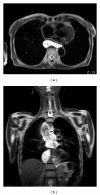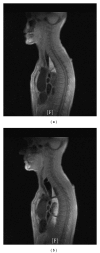Functional magnetic resonance in the evaluation of oesophageal motility disorders
- PMID: 21904543
- PMCID: PMC3166566
- DOI: 10.1155/2011/367639
Functional magnetic resonance in the evaluation of oesophageal motility disorders
Abstract
Functional magnetic resonance imaging (fMRI) has been recently proposed for the evaluation of the esophagus. Our aim is to assess the role of fMRI as a technique to assess morphological and functional parameters of the esophagus in patients with esophageal motor disorders and in healthy controls. Subsequently, we assessed the diagnostic efficiency of fMRI in comparison to videofluoroscopic and manometric findings in the investigation of patients with esophageal motor disorders. Considering that fMRI was shown to offer valuable information on bolus transit and on the caliber of the esophagus, variations of these two parameters in the different types of esophageal motor alterations have been assessed. fMRI, compared to manometry and videofluoroscopy, showed that a deranged or absent peristalsis is significantly associated with slower transit time and with increased esophageal diameter. Although further studies are needed, fMRI represents a promising noninvasive technique for the integrated functional and morphological evaluation of esophageal motility disorders.
Figures


Similar articles
-
Evaluation of esophageal function in patients with esophageal motor abnormalities using multichannel intraluminal impedance esophageal manometry.World J Gastroenterol. 2006 Oct 21;12(39):6349-54. doi: 10.3748/wjg.v12.i39.6349. World J Gastroenterol. 2006. PMID: 17072960 Free PMC article.
-
Esophageal motor disorders: videofluoroscopic and manometric evaluation--prospective study in 88 symptomatic patients.Radiology. 1992 Nov;185(2):487-91. doi: 10.1148/radiology.185.2.1410360. Radiology. 1992. PMID: 1410360
-
Proximal versus distal oesophageal motility as assessed by combined impedance and manometry.Dig Liver Dis. 2009 Feb;41(2):104-9. doi: 10.1016/j.dld.2008.05.003. Epub 2008 Aug 29. Dig Liver Dis. 2009. PMID: 18760980
-
Combined multichannel intraluminal impedance and manometry testing.Dig Liver Dis. 2008 Mar;40(3):167-73. doi: 10.1016/j.dld.2007.11.007. Epub 2008 Jan 4. Dig Liver Dis. 2008. PMID: 18178138 Review.
-
Technological insights: combined impedance manometry for esophageal motility testing-current results and further implications.World J Gastroenterol. 2006 Oct 21;12(39):6266-73. doi: 10.3748/wjg.v12.i39.6266. World J Gastroenterol. 2006. PMID: 17072947 Free PMC article. Review.
Cited by
-
Three-Dimensional Trans-Thoracic Echocardiography of Esophageal Achalasia: Description of a Case.J Cardiovasc Echogr. 2014 Apr-Jun;24(2):57-59. doi: 10.4103/2211-4122.135619. J Cardiovasc Echogr. 2014. PMID: 28465904 Free PMC article.
-
Role of preoperative imaging with multidetector computed tomography in the management of patients with gastroesophageal reflux disease symptoms after laparoscopic sleeve gastrectomy.Obes Surg. 2013 Dec;23(12):1981-6. doi: 10.1007/s11695-013-1003-2. Obes Surg. 2013. PMID: 23754240
-
Magnetic resonance imaging for simultaneous morphological and functional evaluation of esophageal motility disorders.Surg Today. 2014 Apr;44(4):668-76. doi: 10.1007/s00595-013-0617-2. Epub 2013 May 21. Surg Today. 2014. PMID: 23689949
-
MRI patterns of Nissen fundoplication: normal appearance and mechanisms of failure.Eur Radiol. 2014 Sep;24(9):2137-45. doi: 10.1007/s00330-014-3267-x. Epub 2014 Jun 26. Eur Radiol. 2014. PMID: 24965508
-
Review on novel concepts of columnar lined esophagus.Wien Klin Wochenschr. 2013 Oct;125(19-20):577-90. doi: 10.1007/s00508-013-0418-z. Epub 2013 Sep 6. Wien Klin Wochenschr. 2013. PMID: 24061694 Review.
References
-
- Richter JE. Oesophageal motility disorders. Lancet. 2001;358(9284):823–828. - PubMed
-
- Ghosh SK, Pandolfino JE, Zhang Q, Jarosz A, Shah N, Kahrilas PJ. Quantifying esophageal peristalsis with high-resolution manometry: a study of 75 asymptomatic volunteers. American Journal of Physiology. 2006;290(5):G988–G997. - PubMed
-
- Tutuian R, Castell DO. Combined multichannel intraluminal impedance and manometry clarifies esophageal function abnormalities: study in 350 patients. American Journal of Gastroenterology. 2004;99(6):1011–1019. - PubMed
-
- Prabhakar A, Levine MS, Rubesin S, Laufer I, Katzka D. Relationship between diffuse esophageal spasm and lower esophageal sphincter dysfunction on barium studies and manometry in 14 patients. American Journal of Roentgenology. 2004;183(2):409–413. - PubMed
-
- Fuller L, Huprich JE, Theisen J, et al. Abnormal esophageal body function: radiographic-manometric correlation. American Surgeon. 1999;65(10):911–914. - PubMed
LinkOut - more resources
Full Text Sources

